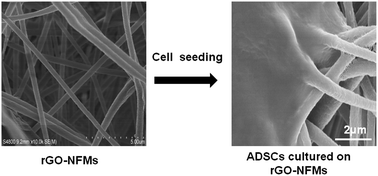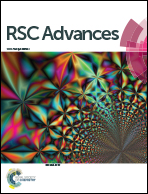Fabrication, mechanical properties, and biocompatibility of reduced graphene oxide-reinforced nanofiber mats†
Abstract
Fibrous functional scaffolds that could mimic the natural growth environment of cells and govern cell-specific behaviors are crucial for meeting the requirements of tissue engineering. Graphene-based materials, which is an important one of them have captured tremendous interests of researchers. However, few research about graphene nanofibers with excellent electrical and mechanical properties have been fabricated and found to have real applications. In this study, we reported a novel PAN-reduced graphene oxide reinforced composite nanofiber mats (rGO–NFMs), which were fabricated by the electrospinning process combined with chemical reduction. SEM, FTIR and XRD revealed that rGO–NFMs were successfully produced. These rGO–NFMs displayed superior mechanical properties (tensile strain and tensile stress are 18.5% and 1.38 MPa, respectively). The cell proliferation and morphology of adipose-derived stem cells (ADSCs as model cells) cultured on the rGO–NFMs were tested with a 7 days culture period. Cellular test results showed that rGO–NFMs exhibited excellent biocompatibility, cells on the nanofibers formed stable cell–fiber constructs, and the rate of cell proliferation was similar to that of tissue culture plates (TCPs) and PAN nanofibers mats (PAN–NFMs). This study demonstrated that rGO–NFMs may be a good choice for application in tissue engineering, particularly cell culture scaffolds for electrical stimulation.


 Please wait while we load your content...
Please wait while we load your content...